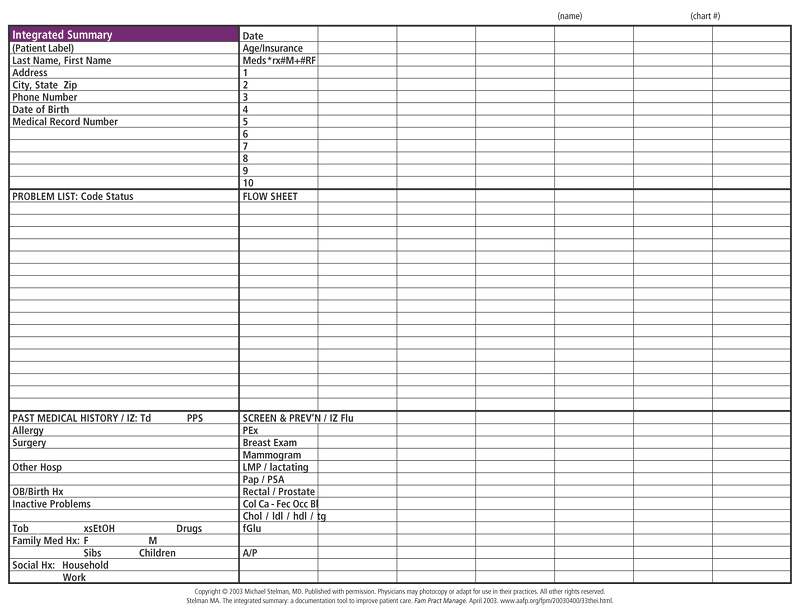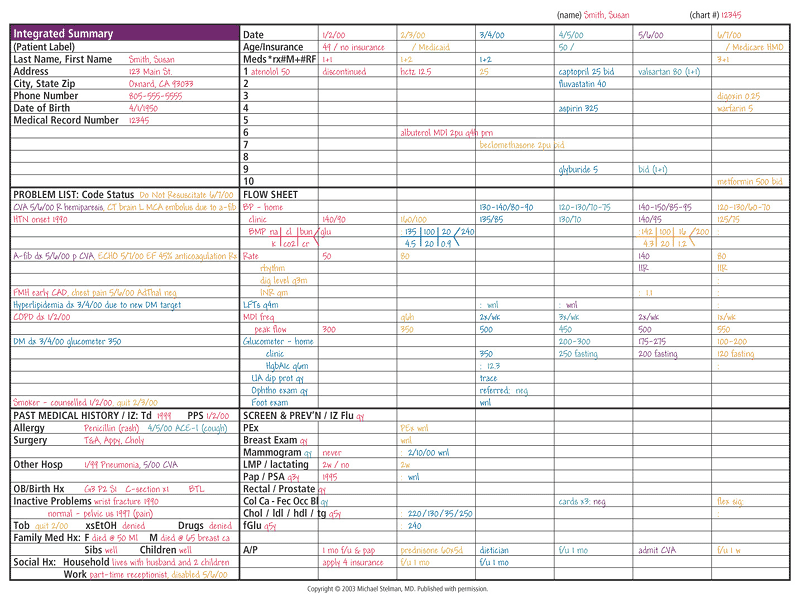
This easy-to-use template enables you to see the full context of a patient’s health on a single page.
Fam Pract Manag. 2003;10(4):33-39

The medical record is an important part of patient care, yet too often it is difficult to use. Patients’ charts are overflowing with information – problem lists, medication lists, disease-oriented flow sheets, laboratory flow sheets, preventive screening flow sheets, immunization lists, and previous histories and physicals. A physician must review multiple pages to find what he or she needs. Then, he or she has to take chronologically listed but unrelated information and mentally reorder it by disease or organ system, gather today’s data, and finally integrate them to develop an appropriate treatment plan.
To provide high-quality, efficient care, it helps to have an up-to-date integrated summary of the patient’s health. The integrated summary is a single concise page kept topmost on the left side of the chart, opposite the most recent progress note, readily available for quick review prior to evaluating the patient. Its major benefits include the following:
It summarizes and replaces the patient’s demographic data, problem list, past medical history, immunization list, medication list and flow sheets, and it provides an abbreviated plan both for today and for future visits all on a single page.
It organizes problems, medications and flowsheet parameters by disease or organ system, not simply chronologically, and integrates them to make their relationships more evident over time.
It eases documentation. The integrated summary requires minimal data entry at each visit, and it simplifies progress note documentation.
It can be easily and inexpensively implemented with nothing other than a photocopier and handwritten entries, or programmed as a component of an electronic medical record (EMR).
It offers a template that can be altered to accommodate the work styles and preferences of any physician.
KEY POINTS
The integrated summary, a one-page, up-to-date summary of the patient’s health kept on the left side of the chart, makes it easier to provide high-quality, efficient care.
The integrated summary organizes problems, medications and flowsheet parameters by disease or organ system and makes their relationships more evident over time.
The integrated summary requires minimal data entry at each visit, and it simplifies progress note documentation.
How it works – template layout and integration
An example of an integrated summary template useful for most adult patients in the author’s family practice can be viewed and downloaded below. The integrated summary has six major panels, organized into two sides. The three panels on the left side of the page contain relatively static data that rarely change; the three panels on the right contain more dynamic data that change with each visit. The right side captures six visits’ worth of key data per page. This might span six weeks in a patient with severe hypertension whose medication is being aggressively titrated or six years in a healthy patient getting yearly mammograms. When the right side becomes full, you can overlay a blank copy of the template, cutting off the three panels on the left and binding the new page to the chart.

The summary is integrated in that it includes data on one page from multiple (and now unnecessary) parts of a traditionally organized chart. More importantly, however, it is integrated in that the relationships between problems, medications and measured flowsheet parameter results are evident on a single page, and their changes (compensated or decompensated, improving or progressing) are readily apparent over time. This allows the physician to follow, for example, the response of the glycohemoglobin (HbA1c) or blood pressure as a function of the number of drugs and their dosages.
At each visit, the physician enters dynamic data into the integrated summary as follows: First, newly available outside test results for tests drawn at the previous visit are entered into the previous visit column. Then current symptoms, vital signs and other physical or in-office lab findings are entered into the column for the current visit (a colon “:” indicates pending results of outside labs or imaging studies). Finally, new medications or dosage changes and newly ordered lab or imaging tests are entered into the column for the next visit (again, with colons to indicate that results are pending).
The clinical example on page 36 describes the case of a hypothetical middle-aged female patient with a fairly complicated set of problems and shows how the integrated summary would be completed over several visits. The sample progress note on page 38 shows how references to the integrated summary can shorten documentation.
Key template sections
The key sections of the integrated summary are as follows:
Patient demographics. Patient demographic data is recorded across the top of the integrated summary. Relatively static data (e.g., name) appears in the upper-left panel. Demographic data that might change more frequently is entered on the right side of the integrated summary and includes the patient’s age and insurance.
“Expanded” problem list. The middle panel on the left is the problem list, where problems are organized by disease or organ system following some sensible order (see the box). Listing problems in the temporal order of their diagnosis requires more mental integration of the data than ordering problems by disease or organ system.
DISEASE/ORGAN SYSTEMS
The author finds it more efficient to order the patient data on his integrated summary by disease/organ system (see below), rather than chronologically.
Regional
Neurologic
Psychiatric
Ophthalmologic
ENT/Head and neck
Cardiovascular
Pulmonary
Gastrointestinal
Nephrologic/Urologic
Obstetric/Gynecologic
Endocrine/Metabolic
Distributed
Dermatologic
Orthopedic
Hematologic
Global
Genetic
Immunology/Allergy/Rheumatology
Oncology
External
Infectious disease
Environmental/Trauma
Problems are entered on the problem list leaving room above and below for subsequent or future entries. For example, as I conduct a new patient history, if the patient tells me about chronic hepatitis first, I may enter this problem about one third of the way down the list. When she subsequently reports congestive heart failure, I can add this to the list above. Six months later, when she develops endometriosis, I can add this to the list below. Physicians may find it useful to expand upon each element of the problem list, adding date of onset, diagnostic criteria, extenuating circumstances at the time of diagnosis and dates of major quantifying test results (e.g., echocardiogram or computed tomography).
A CLINICAL EXAMPLE
To understand how a physician would use the integrated summary in practice, consult the text in this box and the example below, both of which are color coded to facilitate understanding. This example details the care of a hypothetical middle-aged female patient.
1/2/00 (red):
The patient presents for an initial visit. She gives a history of hypertension (HTN), familial risk for coronary artery disease (CAD) and smoking (all of which are added to the problem list), and her exam shows wheezing leading to a new diagnosis of chronic obstructive pulmonary disease (COPD). Her problem of smoking is expanded to document the intervention of cessation counseling. The past medical history (PMH) section is filled in from her history, and the immunizations heading helps to remind me that (now that she has been diagnosed with COPD) she is a candidate for pneumococcal polysaccharide (PPS), which is given. The atenolol she reports taking is entered into the initial column of the medication list. Integrating the problem and medication lists to the flow sheet, I choose the parameters of blood pressure (BP), basic metabolic panel (BMP) and heart rate as appropriate to monitor, and the new diagnosis of COPD suggests adding metered dose inhaler (MDI) frequency and peak flow. Integrated flowsheet values documenting bradycardia and restricted peak flow assist me in recognizing that atenolol is now contraindicated, for which I substitute hydroclorothiazide (HCTZ), and that albuterol is needed, as shown in the next column of the medication list. The dates of her most recent screening exams are entered and aid me in recommending a follow-up appointment (f/u) in one month for an overdue Pap smear (documented in my abbreviated plan at the bottom of the 1/2/00 column). Finally, the demographic entry “no insurance” prompts me to encourage her to apply for insurance to cover future expenses.
2/3/00 (light green):
The patient follows up. The problem list is further expanded to show that the patient heeded my recommendation to quit smoking. Integrated flowsheet parameters for BP 160/100 and MDI use every six hours help me realize that neither her HTN nor COPD problems are compensated, and the next column shows prescriptions to increase her HCTZ and add an inhaled corticosteroid (beclomethasone). The abbreviated plan section also shows that a one-time oral steroid burst (prednisone) was prescribed. The screening section shows that an unremarkable general physical exam (PEx) including a normal breast exam was done, and colons (“:”) show pending results of her ordered BMP, mammogram, Pap smear cytology, cholesterol (chol) and triglycerides (tg), and diabetes screen.
3/4/00 (blue):
The lab results that have returned are entered into the preceding column, including the preceding elevated fasting glucose unbeknownst at the time steroids were prescribed. The problem list adds that diabetes mellitus (DM) has been diagnosed. It also records that the previously acceptable low-density lipoprotein (LDL) result of 130 in last month’s screening column is no longer adequate in light of DM and records the new entry of hyperlipidemia. The integration of her flow sheet helps point out that her improved BP after last month’s medication augmentation is not adequate for the new target of 130/80 for DM, and the next column of the medication list shows that the angiotensin-converting-enzyme inhibitor (ACE-I) captopril is substituted for her HCTZ, a statin is added for her newly diagnosed suboptimal lipids and a hypoglycemic agent has been prescribed. It also shows that prophylactic aspirin has been recommended now that the patient has other CAD risk factors with DM. Flowsheet parameters of glucose, glycohemoglobin (HbA1c), urine dipsticks, ophthalmic and podiatric screens, as well as liver function tests (LFTs) to monitor statin therapy are added and ordered as indicated by the colons. The plan section shows a dietician referral was made, and the patient will follow up in one month.
4/5/00 (dark green):
The PMH section records a new adverse reaction (cough) to her ACE-I, and the next medication column documents its switch to the angiotensin receptor blocker (ARB) valsartan. The results of last month’s tests are recorded in the preceding column of the flow sheet after the colons, and the flowsheet parameters measured today are recorded in the current column. The integrated flow sheet shows the home glucometer readings are suboptimal in response to the glyburide dose recorded above, and an augmented twice-daily dose is recorded in the next column. The increase in her age shown in the demographic section reminds me in my review of the screening section that she is now a candidate to begin annual fecal occult blood testing and cards are given, with results later appended.
5/6/00 (purple):
The patient presents with hemiparesis and is found to be in atrial fibrillation (a-fib) with a rapid ventricular rate and is admitted to the hospital. Problem list is updated accordingly.
6/7/00 (orange):
The patient returns to the office for follow-up after discharge from a stroke-rehabilitation center. Unfortunately, her paresis has not improved. The problem list “Code Status” field reminds me to update her wishes following this change in her health status, and her Social Hx is updated for her disability. The problem list is expanded to annotate the results of major quantifying hospital tests including head computed tomography scan (CT), echocardiogram (ECHO) and adenosine thallium cardiac perfusion scan (AdThal). I update her medication list to reflect that digoxin was started in the hospital for rate control, warfarin was substituted for aspirin for anticoagulation, and that metformin was added for her yet suboptimal glucometer readings. Her flow sheet is modified by adding new monitoring parameters for rhythm, digoxin level and International Normalized Ratio (INR). Hospital admission lab results are added to the preceding column, and colons mark the pending results of tests ordered today. The screening section shows a flexible sigmoidoscopy is scheduled, and the plan section documents a one-week follow-up.

Past medical history. The lower left panel of the integrated summary contains a summary of pertinent past medical history. Immunization (IZ) status for infrequently repeated vaccinations, such as tetanus-diphtheria and pneumococcal polysaccharide, is also included where appropriate.
“Organized” medication list. The top panel on the right leaves room for chronic medications to be entered. Its organized structure allows drugs to be grouped vertically by organ system and horizontally by temporal order of initiation. Grouping like agents (and leaving blanks above and below to add future agents for other systems) makes it easier to associate groups of drugs to a corresponding problem and choose when to titrate existing drugs or add a new agent. New medications and dosage changes are entered in the next visit column. Thus, the values entered in the flowsheet section reflect the effects of the medications and dosages listed directly above them in the medication list section.
A SAMPLE PROGRESS NOTE
The integrated summary simplifies the progress note; it does not duplicate it. For example, for the April 5, 2000, patient visit documented on page 36, the SOAP progress note might read as follows:
S: 50-year-old female returns as directed for one-month follow-up of multiple medical problems, including hypertension (HTN) and diabetes mellitus (DM). She is on half a dozen medications, as documented on integrated summary (IS). Patient notes a cough since starting captopril.
O: Suboptimal home and clinic glucometer readings and glycohemoglobin levels, improved compensated blood-pressure readings and normal monitoring liver function test results are recorded on IS. Other normal findings on exam were …
A/P:
HTN: Now compensated but intolerant of ACE-I. Change to angiotensin receptor blocker per IS. Return to clinic in one month.
DM: Suboptimal control. Augment glyburide dose per IS.
Hypercholesterolemia medication: Monitoring labs per IS.
Prevention: Screening tests per IS.
To save space and time, I enter only changes to medications, rather than rewriting the prescription information for each visit. I use default conventions for “mg” and “qd” when units and frequency are not specified to further minimize data entry. I also encode the number of months supply (M) and number of refills (RF) in an abbreviated fashion “M+RF” (e.g., “1+5” indicates a one-month supply with five refills). One-time prescriptions for antibiotics or episodic symptomatic medications are not recorded in the medication list but, instead, are briefly annotated in the “Plan” section at the bottom of the page.
“Practical” flow sheet. Opposite the problem list is a blank flow sheet. For any problems that require the monitoring of clinical parameters over time, I enter those parameters directly across from (or near) their listed problem. I also list the suggested reassessment frequency for a stable, compensated patient, where needed. The limited space forces me to be practical and limit the parameters I follow for any one disease to only the most important ones (see “A clinical example”). These responses are all easily correlated to (and hence integrated with) the medication dosages immediately above and the problem or disease listed to the left.
Screening and prevention. The lower right panel of the integrated summary records interval screening exams and tests, their recommended frequencies and their results. I also document last menstrual period and lactation here to remind me of drug contraindications in patients who are at risk of conception or who are breast-feeding.
Plan. At the very bottom of the lower right panel are a few lines to abbreviate the interventions done today, tests to follow up, next appointment interval and other plans. Often, this is sufficient to guide my next visit without even referring to my previous progress note.
Making it your own. The use of an integrated summary considerably reduces the time needed to address problems at every stage of the assessment. For new patients, I fill in the blank fields as I interview them and briefly dictate “See integrated summary for current medications, problems and history” in my progress note. For returning patients, I can quickly refresh my memory of their health status, review my prior plan and make a preliminary task list for today’s appointment, usually in less than a minute. It takes only a few seconds during my interview to record today’s data into the flow sheet, write any medication adjustments into the medication list and record an abbreviated plan. To avoid a duplication of efforts, I simply make reference to these entries in my dictated progress note (see “A sample progress note”). Having a single page facilitates compulsively keeping my lists of problems, medications, lab results and screening tests due up-to-date. For a few patients with complex problems, I must keep separate traditional (though organized) medication and problem lists when they exceed the space allotted on the integrated summary.
When sending patients to consultants or the emergency room, or when giving records to patients who are moving away, I often copy just the integrated summary. When dictating admission notes, I often do so from just this one page without the need to resolicit information from the patient or search through the chart. Colleagues covering acute office visits in my absence have a quick summary to guide them as they care for my patients.
The integrated summary template presented here may not suit every physician’s work style or approach to primary care. However, because the integrated summary is a concept, not a fixed layout, it can be customized to suit physicians’ documentation preferences. Requiring only a little practice, the integrated summary is a valuable tool that can help physicians improve the quality and efficiency of patient care.